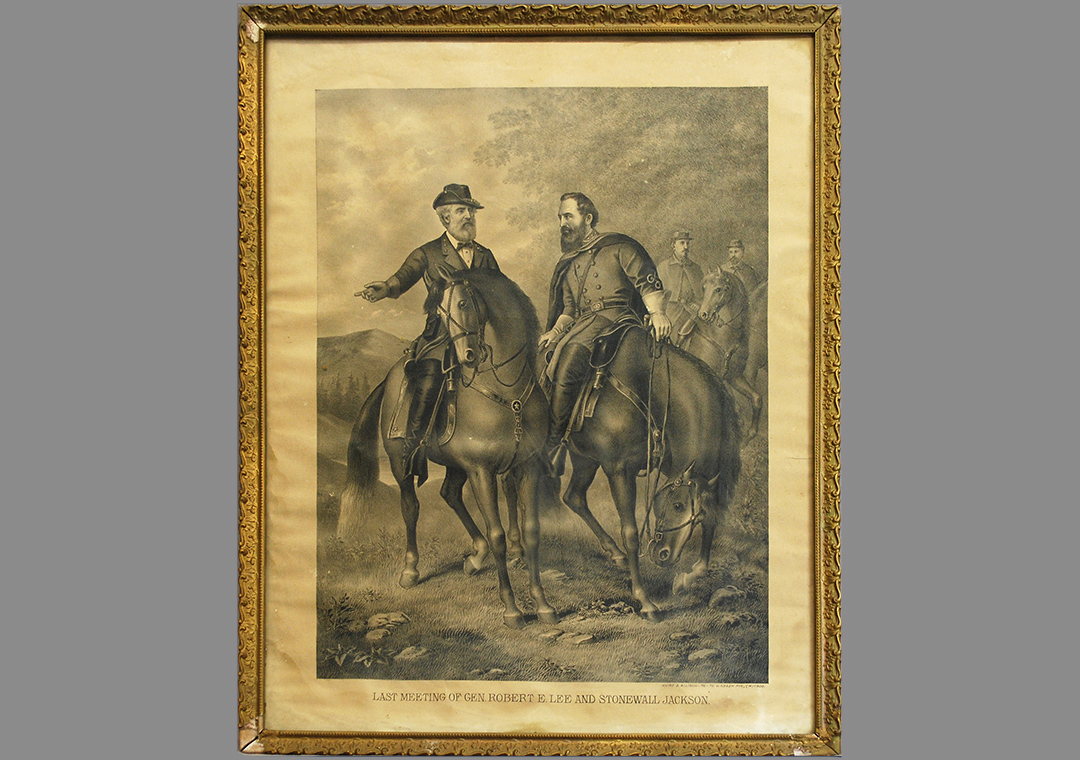The Civil War resulted in the death of more than 600,000 soldiers and many more were injured. After the war ended many Americans wanted to commemorate the war with art, and people like Louis Kurz and Alexander Allison took advantage of this to sell Civil War chromolithographs of famous people or events from the ware. Many of the prints were inaccurate, but they were still popular. Today they are one of the most sought after collectibles. This object is a print by Allison and Kurz depicting the last meeting between Gen. Robert E. Lee and Stonewall Jackson.
The Kurz and Allison publishing company was based out of Chicago, Illinois. Louis Kurz was originally from Salzburg, Austria. Before running his publishing company in Chicago, he had worked as a lithographer in Milwaukee and Chicago. In 1880 he teamed up with Alexander Allison who provided the money to finance the new company known as Kurz and Allison. The image depicted in this print shows Robert E. Lee and Stonewall Jackson, meeting before the battle of Chancellorsville in May 1863. Everett B. D. Julio is credited with creating this image in 1869, but it was a popular subject at the time, depicted by many artists.
General Robert Edward Lee was born in Stratford Hall, Virginia and was the son of a Revolutionary War hero. A young Robert was able to get an appointment to the United States Military Academy at West Point and graduated second in his class in 1829. Lee did not see battle until 1846 during the war with Mexico. Before that, he served in the Corps of Engineers. Lee was then the superintendent of West Point and would be in charge of many young men who would later serve under him as well as against him during the Civil War. Lee left the Academy in 1855 and took a position in the cavalry and was ordered to put down the raid at Harpers Ferry. Lee had a reputation of being a fine officer so it was no surprise that President Lincoln offered him a position to lead the Federal forces. Lee declined and left the army when Virginia seceded, arguing that he could not fight against his own people.
His first battle of the Civil War took place in Cheat Mountain, Virginia and, although it was a Union victory, Lee’s reputation held up to public criticism. Lee became a military adviser for President Jefferson Davis and throughout the war had both losses and victories. One victory was at Chancellorsville which followed the meeting depicted in this print. However, following the Union victories of Gettysburg and Vicksburg Lee realized that the end of the Confederacy was only a matter of time. On April 9, 1865, Lee and his army surrendered at Appomattox Court House. Following the war Lee became the President of Washington College in Virginia, he passed away on October 12, 1870.
The other man shown in the print is Thomas Jonathan “Stonewall” Jackson, he was born on January 21, 1824 and was a good friend of Robert E. Lee. Jackson graduated from West Point in 1846 was a second lieutenant in the Mexican-American War when he first met Lee. When the Civil War broke out Jackson became a Colonel of the Virginia militia and also commanded at Harper’s Ferry. It was after the battle of the First Manassas (aka Bull Run) where he earned the nickname “Stonewall.” With successful military maneuvers at battles including the Second Manassas and Sharpsburg he was eventually designated as Lieutenant General. Jackson was in command at the victory in Fredericksburg and in Chancellorsville.
Following the battle of Chancellorsville, Jackson was returning to his camp with some staff and they were mistaken for a Union Calvary by the Confederate troops. They open fire and Jackson was hit by three bullets, two in the left arm and one in the right arm. Jackson was unable to get immediate medical attention as it was after dark and there was a great deal of confusion. As a result of his injuries Jackson’s left arm had to be amputated. He survived the amputation but had signs of pneumonia which were ignored. Jackson passed away from complications of pneumonia on May 10, 1863.
Both men continue to be studied by historians for their military tactics today. They are both commemorated with various monuments, parks, and schools named after them.
